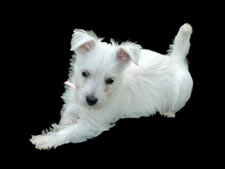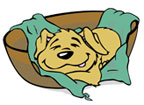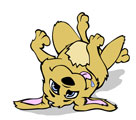West Highland White Terrier (Westie) Dog Breed
Dog Group: Terrier Group
Class: Terrier
Description

The West Highland White Terrier, otherwise known as the Westie, is a very cute and playful little dog. This breed sports a brilliant white coat, complemented by small, very dark eyes and a black nose. This gives the West Highland White Terrier a very sweet, cute and eager expression. The outer coat of the Westie is quite harsh to the touch, but has a softer second coat beneath it. The Westie is a small dog, but has a sturdy, determined look about it. The tail is quite short and stands erect, and the ears small, often hidden away in the hair around the top of the head.
Temperament
The West Highland White Terrier is an energetic and cheerful breed, with a very light-hearted take on life and a streak of excitable mischievousness. This breed loves attention and companionship, and enjoys nothing more than playing with his toys and his family. The Westie can be willful and obstinate at times, and is a very independent thinker. However, this breed gets on very well with children and with early socialization can also get on with other household pets. These dogs are intelligent but can sometime be a little naughty too, so you’ll need to keep your eye on him! The West Highland White Terrier makes a very good family pet, making it one of the most popular breeds around. Its small size coupled with its big character makes the Westie a delightful pet and companion.
Height and Weight
The West Highland White Terrier is a small dog, and averages around 10-11 inches in height. The weight of the Westie can average around 15-22 pounds.
Common Health and Behavioral Problems
Although the West Highland White Terrier is generally healthy, there are some risk factors to look out for. These include: slipping kneecap, deafness, congenital heart disease and hernias.
Ideal Living Conditions
The West Highland White Terrier has bags of energy and will love to play in a garden to yard. However, this breed will adapt well to apartment living providing plenty of exercise and walks are provided.
Exercise Requirements
The Westie is a robust little dog with plenty of stamina and energy. If you don’t have a garden or yard in which he can play, you will need to take him for several short walks each day. The West Highland White Terrier also loves to play, so interactive games such as fetch and Frisbee make a great form of exercise to stimulate his mind and body.
Diet and Nutrition
The Westie is a small dog with a small stomach, so don’t be tempted to overfeed him when he looks at you with those bright, button eyes. Two small portions of dry food per day will help to maintain oral health and keep him nourished. Also, always provide access to fresh, clean water.
Life Expectancy
The average, healthy West Highland White Terrier can expect to live for around fifteen years or more. Obviously, this is dependent upon overall health and lifestyle.
Grooming Requirements
The white coat of the Westie will unfortunately show any signs of dirt, so this breed may need to be bathed around once each month. You should also brush the Westie’s coat several times each week to keep it clean and in good condition.
Origin
The West Highland White Terrier originates from Scotland, and is thought to be a descendant of the Scotch Terrier. Their original purpose was to hunt and kill vermin, and they were also known as Poltralloch Terriers. This breed has been crossed with Cairn, Scottish and Dandie Dinmont Terriers, and the purebred Westie was first registered by the American Kennel Club in 1908.
 |
 |
Secrets to Dog Training: Consultation
Secrets to Dog Training offers a free consultation with every order! Here is one submitted by Simone about her West Highland White Terrier mix called Tamsin...
Mark's Consultation
Dear Daniel
I have been using your techniques for training my new puppy, however, I have question for you regarding my puppy being on the leash outside. My puppy is a West Highland Terrier and almost 5 months old, and when I take her outside to do her business, I have a very difficult time getting her back into the house. She is very stubborn, and I almost have to drag her in, as she is fighting back. I normally do not have any problems while she is on the leash, except when it is time for her to come back in, or if she sees the neighbor dog outside. Do you have any suggestions?
Also, she will run up the steps from the outside, there are about 5 steps, but she will not yet climb the steps in the house to the 2nd floor. I've put her in the middle of a step, but she just freezes up, and will not climb the rest. She may still be too young to climb steps, and not ready for them, perhaps that will come in time.
Please let me know your thoughts. Thank you,
Mark
Secrets to Dog Training Reply:
Hi Mark,
Thanks for the email regarding your 5 month old Westie. The problem you are encountering is relatively common among our customers and, with time, is relatively simple to correct. First of all, I recommend you read the bonus book - "Secrets to becoming the Alpha Dog". I tell everyone to read this, not because I assume everyone has dominance problems with their dogs, but because being the alpha dog is the base of all obedience training and your dog is more likely to listen to you once it knows you are the pack leader.
As for the behavior of not behaving appropriately only at this certain time on the leash, I would firstly like you to try the following technique used for leash pulling. The leash pulling problem can be relatively easily fixed by teaching your dog the 3 stages of the Heel command as outlined in Secrets to Dog Training. I have copied in the text from Stage 1 of the process below; even this stage should give you good results.
Stage 1
- The first stage of teaching your puppy to heel is to prevent him from pulling on the leash at all.
- You will need to have the collar and leash on your puppy.
- Stand next to and to the right of your puppy so that you are both facing in the same direction and the puppy is sitting on your left.
- Start walking forward slowly in a straight line, leading with your left leg. As soon as your puppy takes off and starts pulling on the leash, stand still and pull the leash back towards you. Do not drag the puppy back towards you. All you need to do is halt its progress.
- Wait until the puppy stops, praise it and then continue walking. No command needs to be given at this stage as you are just trying to teach your puppy good manners so that it can more easily understand the Heel command when the time comes to teach it fully.
- If you apply this method for ten minutes at a time and for three or four times per day then within four or five days you should be ready to move on to the next phase.
It is quite likely that you will get good results within a few minutes, at least enough that your puppy will stop pulling you all over the place. It will be of utmost importance to use this method after you have taken your puppy to the toilet since or when there is another dog nearby, from what you have said, these seem to be the only real times your puppy pulls on the leash.
There are another couple of methods you may try if this doesn’t help and they involve modifying the way you are training your dog slightly. When your puppy has finished toileting and you go to take her back inside and she starts to pull, you need to:
- Stop and give your puppy’s leash a few tugs, and growl the guttural growl, ("AAHH!" rather then "NO") then bring her back beside you.
- Start walking away again and hold a treat by your side (so that your puppy knows it is there).
- Your puppy should be following along side you, if she tries to jump for the treat ignore her (do not let your puppy bite at your hand though).
- When your puppy tires of that, and simply walks along beside you say "HEEL!" then reward your puppy for walking beside you.
Repeat this over and over until you start to see results. If you praise your puppy as it comes towards you then she is being rewarded only for backing up (the very last action it performed). You need to reward your puppy for walking freely beside you as you move off from the stand still. I also recommend that when you do get your puppy back inside that you reward her with a treat, take the leash and collar off and have 4-5 minutes of playtime telling her she is “A Good Girl!!”
As for the step climbing problem, I believe that you are correct in thinking it will pass with age. Puppies can tend to be scared if the steps they are climbing up do not have backings. This is hard to explain via email, but some indoor stairs only have the planks of wood you step on with nothing vertically between each step. Because of this the puppy can see the floor below and how high it has climbed. I hope you understand what I mean, it is hard to explain! Basically if you have steps like this you will need to train your puppy with plenty of praise and rewards one step at a time over the next few months. It definitely isn’t a major thing and I believe she will very quickly get used to the idea of climbing these stairs.
I hope this helps. If you are patient, persistent and consistent with these methods, I believe you will have success relatively quickly.
Best of luck and let us know how you get on in the following couple of months.
Kind regards,
Daniel Stevens
Secrets to Dog Training Team
http://www.kingdomofpets.com/dogobediencetraining
More Resources
 |
 |
Want to find out about more dog breeds? Search here or go to our Dog Breed index.
Got Dog Obedience Training or Problem Behavior Issues?
Is your dog trying your patience on a daily basis? Are you constantly faced with a dog that displays one of the following issues? To find the solution to your problem click on it.. you'll discover the answers to it and other common dog problems you may be facing.
This is the most comprehensive book on dog training and behavior problems around. Best of all... You can download this book to your computer and be reading and using the professionals training techniques in minutes.
About The Author
Daniel Stevens is the renowned dog trainer and author of Secrets to Dog Training: STOP Dog Behavior Problems!, one of the leading dog training guides on the market today selling over 25,743 copies (and counting). He currently heads the Kingdom of Pets dog training team.

